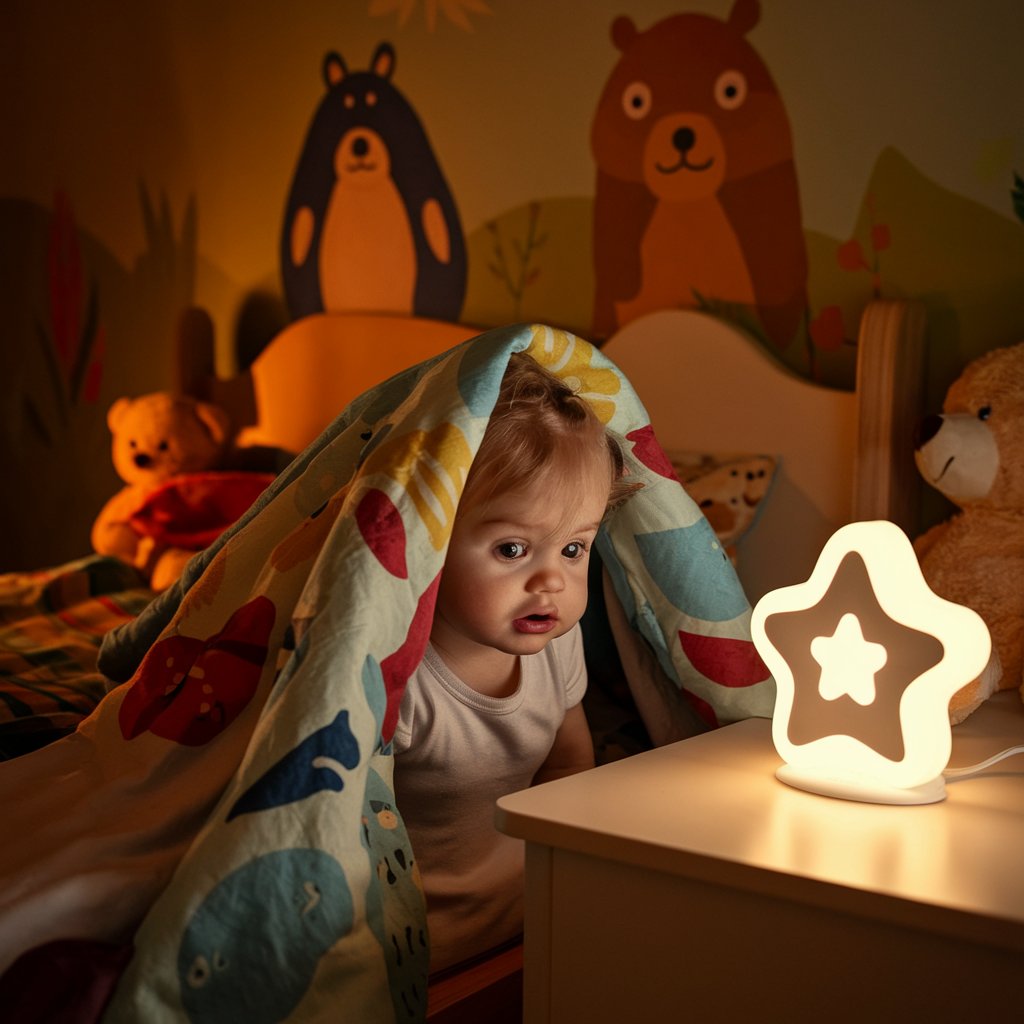It’s completely normal for young kids to feel scared, especially when it comes to a toddler fear of the dark. Feeling anxious helps children deal with new situations and keeps them safe from things that might be dangerous. For toddlers and preschoolers, fears often show up in certain ways, like being scared of bugs, dogs, the dark, clowns, or even the vacuum cleaner. Sometimes, their fears can be more general, like being nervous about new places or meeting people they don’t know.
At this stage in life, your child has an extremely active imagination, which can make them more prone to fear, including a toddler’s fear of the dark. They might be terrified of imaginary creatures or overly concerned about unlikely disasters. Sometimes, they may fixate on what scares them, whether it’s drawing, talking about it repeatedly, or acting it out during play. This behavior is their way of processing and working through their fears.

What You Can Do to Help Your Child Manage Their Fear of the Dark
Most fears, like the toddler fear of the dark, will slowly go away as your child becomes more confident and learns to tell what is real and what isn’t. However, there are ways you can help them manage their fears in the meantime.
- Acknowledge Their Fears.
Even if their fear seems silly to you, it feels very real to them, especially when it comes to the toddler fear of the dark. Whether they want to check for monsters under the bed or refuse to go outside because of a neighbor’s dog, it’s important not to laugh or brush off their worries. When you reassure your child, you show them that it’s okay to be scared and that there are ways to deal with those fears. Dr. William Coleman, says it’s important to talk directly about their fears. “Fears won’t go away if you just ignore them,” he explains. Help your child by naming what scares them and having open conversations about it instead of dismissing their feelings. - Avoid Dismissing Their Fears.
Telling your child that there’s nothing to be afraid of might make them more upset. Instead, offer empathy. Say, “I understand the dog scares you. Let’s walk past it together. If that’s too much, I’ll hold you while it walks by.” This approach acknowledges their feelings while encouraging them to face their fears with support. - Provide Ways to Express Their Feelings.
If your child’s fear stems from anxiety about a big change, like starting preschool or the arrival of a new sibling, give them opportunities to express these emotions through play. For example, pretend play can help your child work through complex emotions related to their fears.
Simple Techniques to Alleviate Your Toddler’s Fear of the Dark
- Explain, Expose, and Explore.
Sometimes, a simple explanation can help ease your child’s fears, like the toddler fear of the dark. For example, you can explain that “only water and soap go down the drain, not people or toys” to ease their fear of bath time. Showing them that the vacuum can pick up dirt but not their toes might help, too. You can also gradually expose them to what they fear, like taking a walk outside at dusk to make the dark seem less scary. If their fear comes from a past experience, like getting a shot, don’t lie about it. Let them know that the shot might sting but will be over quickly, and that you will be there with them the whole time. - Use a Comfort Object.
Many toddlers and preschoolers find solace in a special blanket or stuffed animal. These “loveys” can be especially reassuring during times of change, such as getting dropped off at daycare or going to bed. Allow them to hold onto their security object when needed—it can help them feel safe in unfamiliar or frightening situations. Over time, they’ll likely outgrow the need for it as they learn other coping methods. - Problem-Solve Together.
Work with your child to find solutions that give them a sense of control. For example, to combat fears of monsters under the bed, use a nightlight or create a “monster spray” (a bottle of water) that they can use before bedtime. Empowering your child with tools to address their fears can help them feel less vulnerable.
Effective Strategies for Addressing Toddler Fear of the Dark
- Practice Through Pretend Play.
Role-playing can be an effective way to help your child overcome fears. If your child is afraid of the doctor, pretend they are the doctor and act out a visit. If they’re scared of strangers, practice introducing dolls or stuffed animals to one another. Play is a safe way for children to process and confront what frightens them. Group play can also help preschoolers manage their anxiety. Playing dress-up or creating fun “scary” scenarios with friends gives them a chance to take control of what scares them in a supportive environment. - Manage Your Own Fears.
If your child sees you reacting fearfully to certain situations, they may adopt similar anxieties. It’s important to work through your own fears, or at least not let them show when you’re around your child. However, sharing that you used to be afraid of something too, but learned how to manage it, can provide comfort.
Read More: Team Building Activities for Kids: Fun and Engaging Ways to Build Connections
How to Deal with Sibling Rivalry: Understanding and Managing Common Conflicts

When to Seek Professional Help
While some fear and anxiety are normal for young children, there are times when a child’s fears may require extra attention. You should consider speaking with your child’s doctor or a child therapist if:
- The fears are consistently interfering with daily activities, such as avoiding bedtime due to fear of the dark.
- The fears seem to be escalating over time, which could be a sign of a phobia or anxiety disorder.
- Your child becomes so overwhelmed by fear that it’s impossible to calm them down.
By acknowledging your child’s fears and providing support, you’ll help them develop the confidence to manage their emotions and eventually overcome what scares them.
Read More: Why Do Kids Bite? Understanding the Reasons and Solutions
Nail biting: Why it Happens and What to Do About It











1 thought on “How to Help with Toddler Fear of the Dark: Tips to Comfort and Reassure”